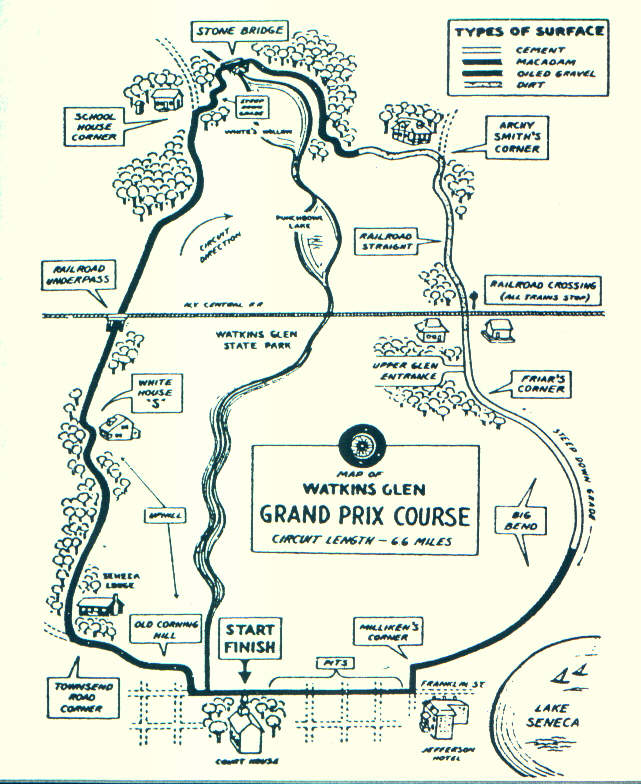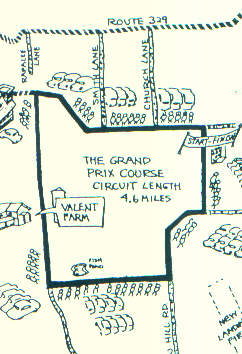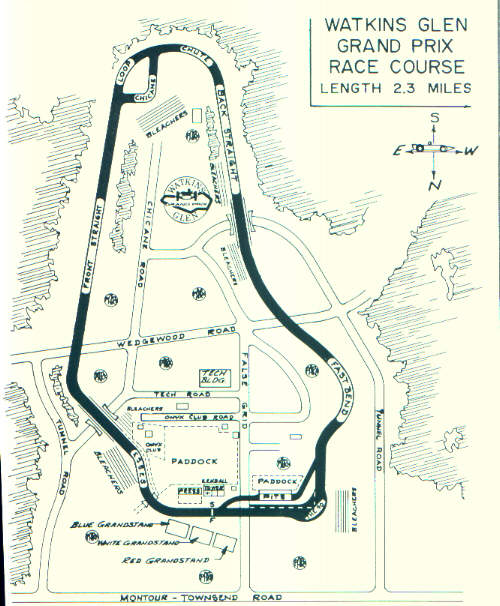

The 1949 Grand Prix was won by Miles Collier in a Ford-Riley [1], narrowly defeating Briggs Cunningham in a Ferrari. The 1950 Race (the first on the FIA calendar, via the AAA contest board), brought tragedy to Wakins Glen for the first time. Sam Collier was killed when his car fishtailed and rolled during the race, and earlier in the day, a car left the road, injuring a fireman and two spectators. The race itself was won by Erwin Goldschmidt in a Cadillac Allard.
Change started in 1951; there was a need to spend real money on a communication system, and gain better control of the spectators. After some debate, it was decided to continue with SCCA sanction (which championed amateur racing) rather than switching to AAA sanction (which championed international racing, and was supported by Cameron Argetsinger). The 1951 race was relatively uneventful after that; it was won by Phil Walters in a Cunningham C-2 with John Fitch in second. That same day, George Weaver of Boston won the Seneca Cup in a Maserati V8R1, and the Queen Catherine Cup in a Jowett Jupiter.
1952 was the last year of the original circuit that passed through the center of town. During the Grand Prix, tragedy struck at Watkins Glen for the second time: a car left the course on the start-finish straight in town, entering the crowd. 12 spectators were injured and 1 died. The day's race schedule was abruptly halted, and never completed; the race would never pass through town again.
 In response to the events in the 1952 Watkins Glen Grand Prix, the State
of New York kept threatening to impose new policies forbidding racing on
state highways, but the subsequent difficulty in obtaining insurance
for the course made this unnecessary, and it
effectively ended racing on the original circuit. After some searching, a
location was selected in the Town of Dix, on the top of a hill to the
southwest of town. A 4.6 mile course was selected using existing Town roads,
agreements were reached with surrounding land owners, and a lease agreement
was signed with the Town. The Watkins Glen Grand Prix Corporation was formed
by the Chamber of Commerce to manage the race. George Weaver and William
Milliken were consulted and the roads that had been selected were improved
prior to the race. Spectator control, parking and concessions were all
dramatically improved at the new site. However, the SCCA choose not to
sanction the 1953 Watkins Glen Grand Prix.
In response to the events in the 1952 Watkins Glen Grand Prix, the State
of New York kept threatening to impose new policies forbidding racing on
state highways, but the subsequent difficulty in obtaining insurance
for the course made this unnecessary, and it
effectively ended racing on the original circuit. After some searching, a
location was selected in the Town of Dix, on the top of a hill to the
southwest of town. A 4.6 mile course was selected using existing Town roads,
agreements were reached with surrounding land owners, and a lease agreement
was signed with the Town. The Watkins Glen Grand Prix Corporation was formed
by the Chamber of Commerce to manage the race. George Weaver and William
Milliken were consulted and the roads that had been selected were improved
prior to the race. Spectator control, parking and concessions were all
dramatically improved at the new site. However, the SCCA choose not to
sanction the 1953 Watkins Glen Grand Prix.The actual race was won by Walt Hansgen in a Jaguar XK120C; second place went to George Harris in an Allard. There were no major incidents in the race. In light of the relative safety of the new circuit, the SCCA choose to renew sanction for the 1954 and 1955 races. The 1954 race was won by Phil Walters in a Cunningham C4R [2]. Trouble surfaced in 1955; it became clear that it would not be reasonable to continue using closed public roads that doubled as farm roads, and the drivers expressed concern about poor runoff and poor visibility. The decision was made to build a permanent road course, and the 9th Watkins Glen Grand Prix would be held in 1956 on an all new race course. Thus, the second course only lasted 3 years.

The Grand Prix committee decided to hold a "get together" race at the circuit on October 20th and 21st; the turf war continued as the SCCA announced a ban on SCCA driver participation. The race was held anyway, with a small but friendly turnout. The turf war burned out; the SCCA inspected the circuit, asked for a small and reasonable list of changes, and and in early 1957 formed the Glen region of the SCCA. The Watkins Glen Grand Prix committee made all the requested changes and more; the SCCA ban was lifted, peace was restored, and on July 5th and 6th, the Glen region put on the First Annual Glen Classic SCCA Regional.
The 10th Watkins Glen Grand Prix subsequently occured on the traditional 3rd Saturday of September, 1957, with Cameron Argetsinger as SCCA Chief Steward (as well as race director and organiser - he also sometimes enterred the races). There were over 225 entries, and no serious incidents. The Grand Prix was won by Walt Hansgen in a D Type Jaguar; fast lap was set by second place finisher Bob Holbert in a Porsche RS.
The NASCAR Grand National Division came to town in 1957, followed by the international Formula Libre in 1958. The U.S. Grand Prix then became a fall tradition in 1961 and was held at the Glen for 20 years. In the seventies the Glen played host to a variety of events, from Can-Am and Trans-Am racing to the Formula 5000 and the CART Indy car series. However, it came on tough times and closed its doors in 1981 to professional racing, filing for bankruptcy and falling into disrepair, although the SCCA held races there on a regular basis. It was saved when a subsidiary of Corning Glass Works purchased it in 1983 and formed a partnership with the International Speedway Corporation.
The "short course" follows the rough outlines of the third course, with turns 2, 3, and 4 corresponding to turns 1, 2, and 3 of the third course. Turn 5 ("the Loop") corresponds to turn 4 on the final version of the third course. Turn 6 of the short course (turn 10 of the long course) is a dramatic (and rather tighter) revision of the third course turn 5; the remainder of the fourth course is distinctly different from the third course, relocating pit lane and the pit straight (the relocation of the pit lane triggered the turn renumbering for those parts of the third course that were retained in the fourth course.)
A chicane known as the "Inner Loop" was added in the early 1990s after the tragic death of NASCAR Winston Cup driver J.D. McDuffie in a Turn 5 accident; this chicane was added on the right side of the back straightaway, just before the entrance to "The Loop". It is numbered as 4 distinct turns (Turns 5, 6, 7, and 8), although it is generally taken as two turns. When the chicane is used, 4 is added to the turn numbers for all subsequent turns on the course.
The International Speedway Corporation in 1983 had purchased 21% of the controlling stock, and over the years it gradually increased its holding until it gained 100% in 1998.
History written by Richard P.Welty